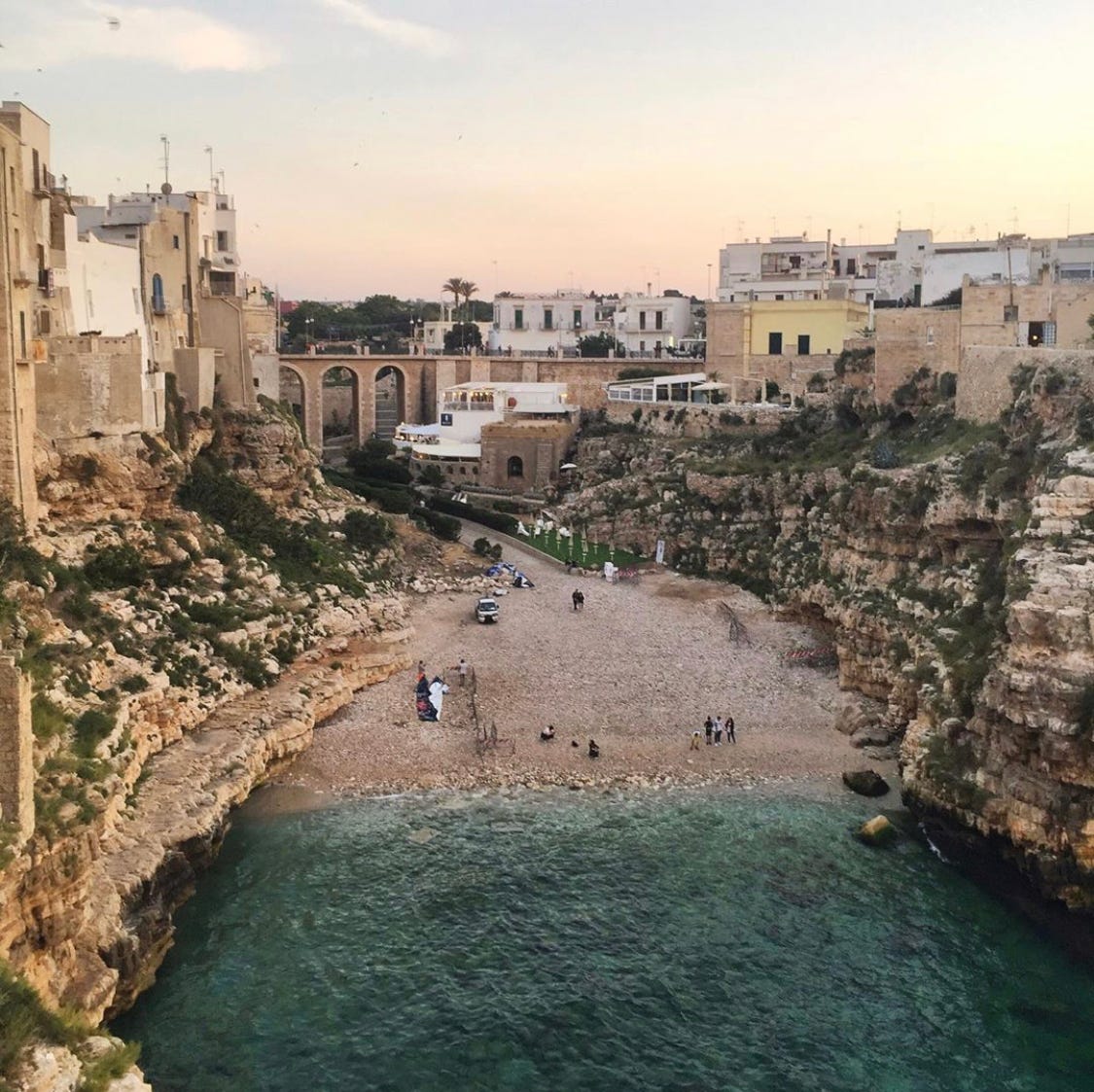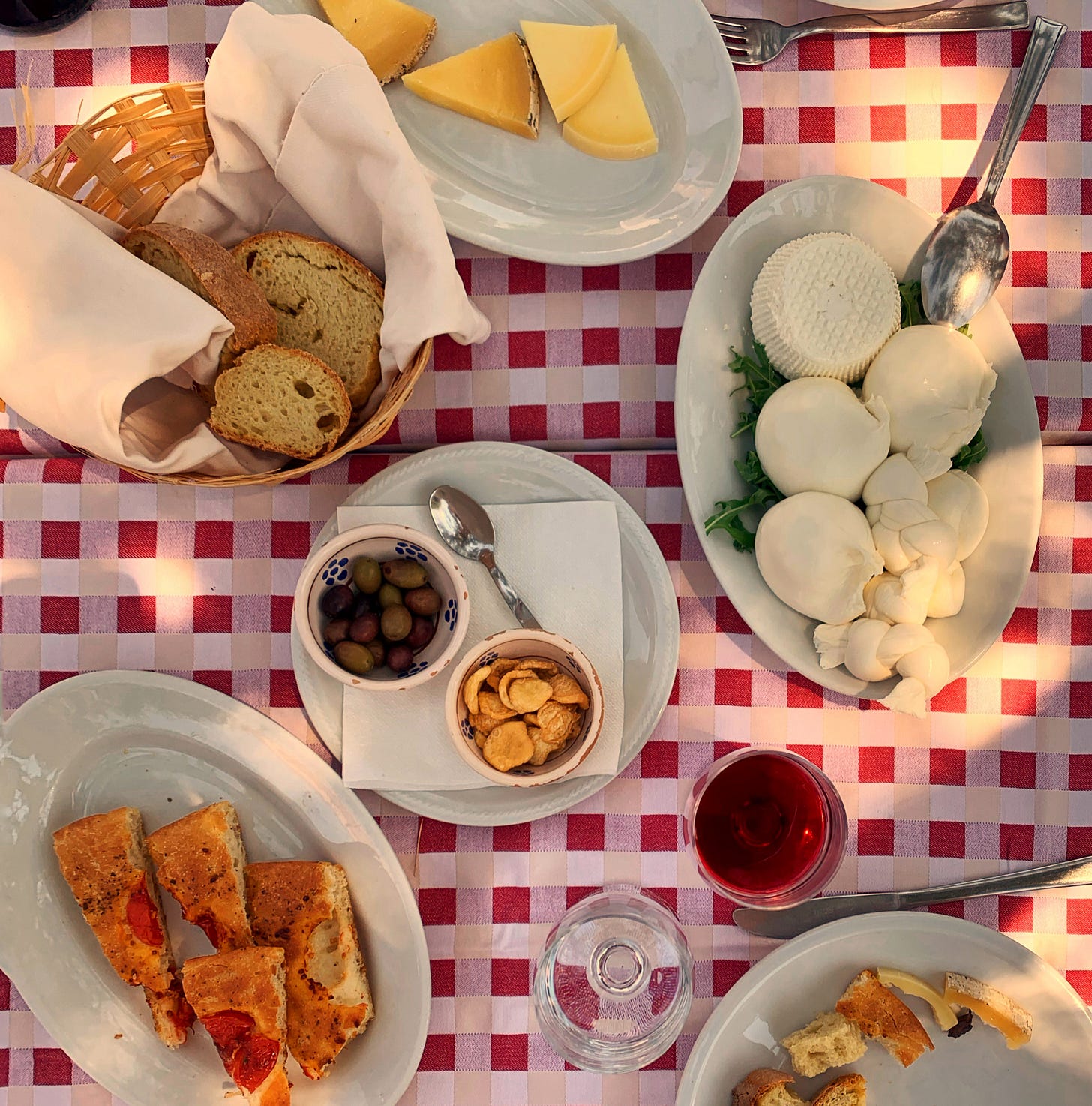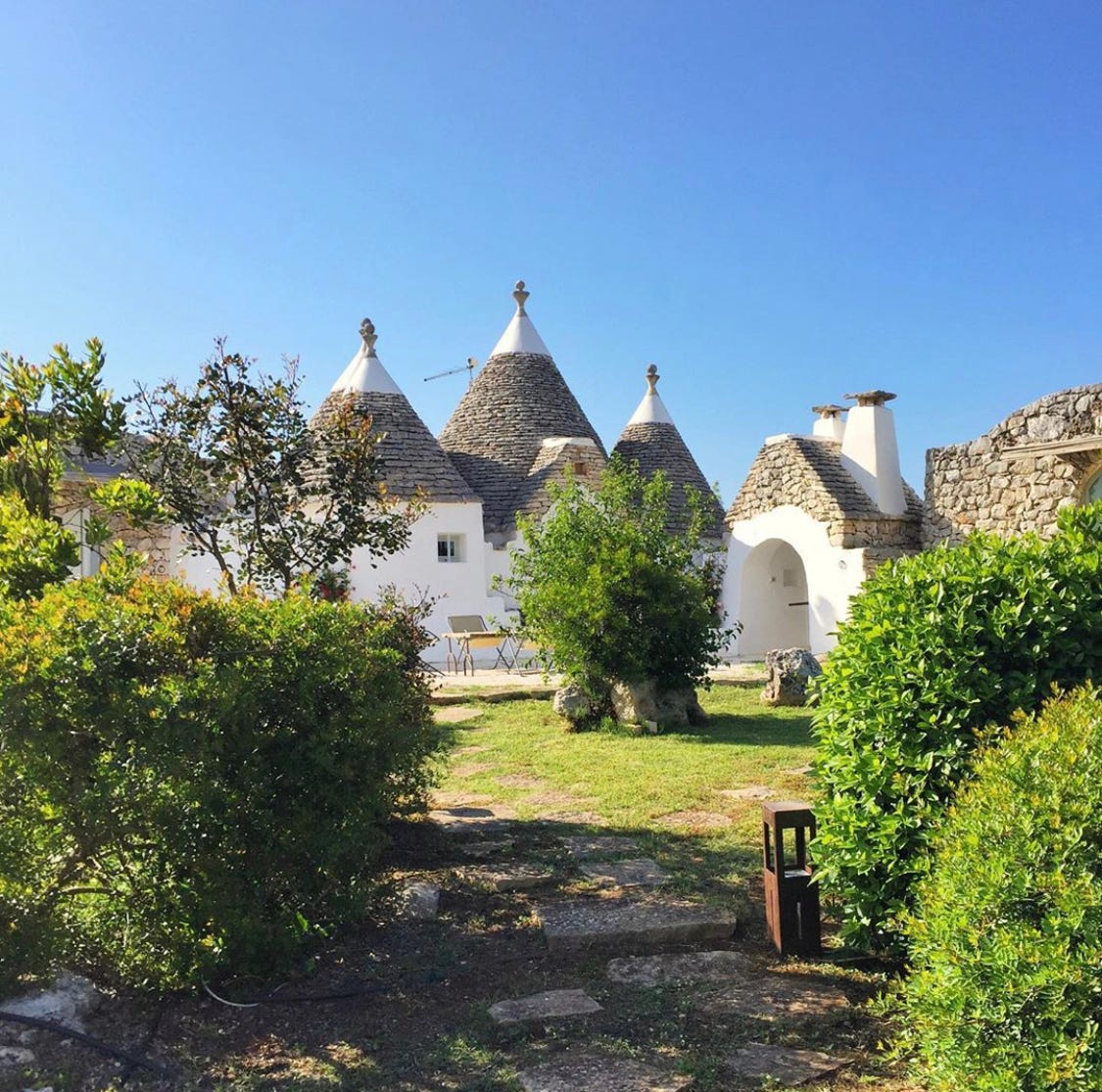Puglia—pronounced pooleeuh—may not have the same name recognition as Italy’s major cities or the glitzy Amalfi Coast, but it’s definitely becoming more popular among international travelers. I have vague recollections of Italian friends mentioning summer vacations in Puglia when I lived in Rome 12 years ago, but it really came onto my radar when I fact checked a big, glossy feature about the region for Travel + Leisure circa 2015. As far as I can remember, the article was all about lazy days spent at the beach, swimming in the sea, sunbathing, and slurping spaghetti with clams. And while you certainly can have that kind of experience in Puglia, there’s so much more to this beautiful area. A reader recently wrote to me asking for tips for a Puglia trip she’s planning for late May and early June, so I thought I would dedicate this issue to the region.
Located in Italy’s deep south, in the heel of the boot, Puglia is a favorite summer destination for Romans. What it lacks in monuments it makes up for in beautiful beaches, charming little villages, and an idyllic countryside dotted with olive trees and vineyards. A trip to Puglia introduces you to another side of Italy, where simple pleasures reign and locals hold fast to traditional ways of life.
Historically, Puglia was a poor rural region, so its culinary specialties tend to reflect that. Fresh pasta is made using only flour and water because eggs were too expensive. Bread crumbs are sometimes sprinkled on top of pasta dishes instead of cheese for the same reason. Yet Puglia is full of agricultural riches—it’s Italy’s leading olive oil producer and second-largest wine producer by volume, even if its wines aren’t prized as highly as those of Tuscany and Piedmont. When it comes to quality, Puglia’s burrata can’t be beat. Burrata di Andria is famous throughout Italy and one of my favorite experiences in Puglia was a burrata demonstration and tasting at Agriturismo Aglio Piccolo in Noci, a small town near Locorotondo.
The first time I visited Puglia, Marco and I started at Borgo Egnazia, the luxurious resort (and member of the Leading Hotels of the World) modeled on a traditional Pugliese village where Justin Timberlake and Jessica Biel got married. My mom, my sister, and her husband (then boyfriend) then joined us and we moved to Trullo Melograno, a charmingly rustic villa rented by The Thinking Traveller before continuing south for a few nights at the truly spectacular villa Il Tabacchificio, also available via The Thinking Traveller.
Trulli (the plural of trullo) are common throughout the Valle d’Itria and date back to the 11th century. You’ll see their conical limestone roofs dotted throughout the countryside, often behind low stone walls. Legend has it that during the Medieval period, when Puglia was ruled by feudal overlords, the peasants who lived in the trulli would dismantle them by pulling a cord in the roof when the tax collectors came and rebuild after they had left. Staying in a trullo is one of the most unique experiences you can have—and there are plenty of renovated ones available on Airbnb and through villa rental companies. The town of Alberobello has Puglia’s highest concentration of trulli, making it a must-visit stop on a trip to Puglia. Protected by UNESCO, many of Alberobello’s trulli have religious or mythological symbols painted onto their roofs.
I highly recommend making a trullo in the Valle d’Itria your base and doing day trips to nearby towns and beaches. You’ll need to rent a car, since public transit in this part of Italy isn’t great, but it’s easy since you’ll mostly be driving on country roads without much traffic. Just keep in mind that when visiting the towns, you’ll have to park outside the centro storico and go into the historic area on foot.
Be sure to visit Polignano a Mare, with its famous limestone cliffs surrounding a little beach. When I went back this year with Marco and a friend visiting from the U.S., we did a boat excursion to the grottos surrounding Polignano a Mare with Pugliamare and then had lunch at Pescaria, a cute spot that makes excellent seafood sandwiches.
Another must-visit town is Ostuni, known as la città bianca (the white city). The centro storico rises on a hill and looks like the kind of town you’d see in the Greek Islands (not so surprising, since this part of Italy is on the Adriatic Sea). Spend a few hours wandering the narrow streets full of shops, restaurants, and bars. On the advice of my friend Zoe Stella Shapiro, who organizes trips to Puglia through her company Stellavision Travel, we skipped the famous aperitivo spot on the steps and went to ABC Apulian Bistrot for dinner—we didn’t regret it.
A couple of other cute towns worth visiting are Monopoli and Cisternino, which is designated one of the borghi più belli d’Italia (most beautiful villages in Italy). Book a table at Doppiozero in Cisternino for some of the best pizza in Puglia. If you want to pick up some ceramics, the place to go is Grottaglie. I became obsessed with the paint splatter dishes you see everywhere in Puglia and got a full set by Enza Fasano—the best ceramicist in Grottaglie—as a wedding present from my sister and her husband.
I’ve only explored a bit of Salento, but as you go deeper south into this part of Puglia, the beaches become even more beautiful. There’s even a beach—Pescoluse—known as the Maldives of Italy. The most important city in this part of Puglia is Lecce, sometimes called the “Florence of the south” because of its rich artistic heritage. The city is full of Baroque architecture and artisans creating all sorts of beautiful things. My family and I did a tour of Lecce with a local guide through Imago Artis Travel and loved every minute of it. He pointed out incredible architecture, brought us inside an aristocratic palazzo, and to a cooking class where we learned to make orecchiette, the most characteristic Pugliese pasta shape.
The next time I go to Puglia, I would like to explore more of Salento and its incredible beaches. I’ve spent most of my time on the Adriatic side, but locals swear by the beaches on the Ionian side, where the water is always calm. This year, when we arrived for our lunch reservation at a beach club near Ostuni, we found that to our surprise it had mysteriously burned down, so I’ll have to look for some new spots.
Further Reading
If you’re curious to know more about Puglia’s fascinating trulli, check out this article I wrote for Fodor’s Travel.
You can learn more about some of the places mentioned in this issue, as well as a few others, in this article I wrote for Architectural Digest about how to plan the perfect road trip in Southern Italy.
Puglia has a long tradition of artisanal pottery. I interviewed Enza Fasano for this guide to Italy’s many styles of hand-painted ceramics for House Beautiful.
My editor at Prior asked me to write this guide to Puglia’s best beaches.
Planning a trip to Puglia and want to know more about beach clubs and what to pack? Check out this guide to European beach etiquette that I wrote for the Points Guy.
If you’re going to Puglia, you might want to add on a day trip to Matera. I wrote all about why you should visit the 2019 European Capital of Culture for the Points Guy.









